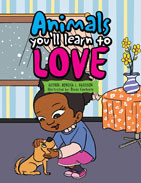
 |
At its core, Harrison's children's story is heartwarming, both in the rhythmic nature of the writing and the dazzling illustrations. Split into two parts featuring Lynn and Bully's unexpected union and the story of Thumbelina, the cat who yearns to go outside, the narrative digs deeper than just a stirring story. It touches on many essentials, such as building a strong understanding of animal welfare and ensuring that they are treated with unconditional love and respect. The reason these are so important is because many animals are entirely dependent on humans.
Geared to the new, learning reader, the story contains a simple writing structure that reads like poetry, making it ideal for kids to read alone or for parents to read aloud as a bedtime tale. In Bully and Lynn's story, the childlike innocence and exuberance shine through and emit qualities such as empathy for all and a pure love that too often gets left behind in childhood. In the same vein, Harrison's work is littered with lessons of responsibility and accountability. For example, when Lynn hears Bully's yelp in the woods, she takes responsibility for his well-being by bringing him home while simultaneously agreeing to hold herself accountable by taking care of all of Bully's day-to-day needs.
Whereas Bully and Lynn's relationship is one of best friends, adventure, and companionship, Thumbelina's story is one of warmth and hope. In particular, the image of Thumbelina's gleaming yellow eyes as they gaze beyond the windowsill and aspire to experience the outdoors is reminiscent of Fitzgerald's The Great Gatsby—specifically, the iconic green light on Daisy's porch. Similarly, another illustration juxtaposes the warmth of her pet parent and the intensity of flames, with Thumbelina resting comfortably and at peace in between.
In an era when animal advocacy is reaching ever greater heights, more and more cases of animal brutality are coming to light. What Harrison does effectively is two-fold. First, she gives children an opportunity to ignite their imaginations with limitless possibilities and color. At the same time, she provides a roadmap for young minds to understand how animals should be treated and, in her own words, just how precious they are. Perhaps through animals, the author is not simply hinting at how one should treat animals but also how one should treat each other with the same kindness and compassion, regardless of the color of our skin, the breed or species we may be, the language we speak, or any element of our being that can be perceived as divisive.
On a stylistic level, the book is a treat for readers transitioning from pure picture books but not quite ready for chapter books. The short, succinct sentences that focus on dreaming, hope, and, above all else, possibilities infuses a ray of positivity into the story that gives readers a belief that pets like Bully will always find their Lynn, and cats like Thumbelina will one day get to explore the outdoors to their hearts' content. Sweet and endearing in every way, Harrison's work offers a mirror for young and old alike to see what the world looks like through the kind, loving, and accepting lens of a child.